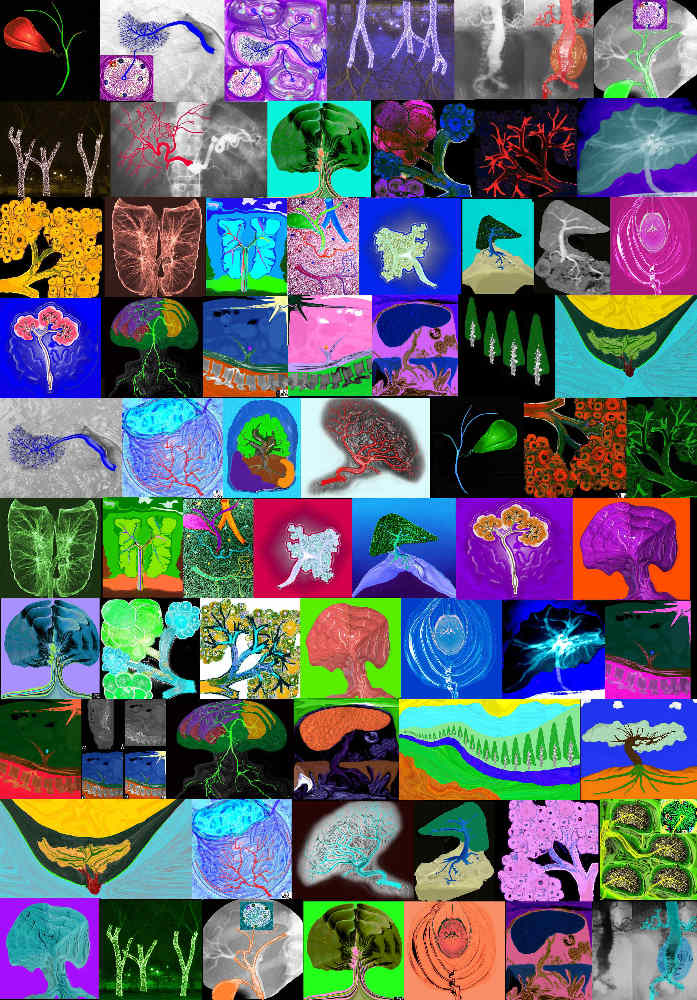
Ashley Davidoff MD
thecommonvein.net
Transport System – Delivery
- The organization of the many of the structures in the body in the form of a tree like branching system with tubular components, is a recurring and highly successful system of organization that ensures delivery to and removal from many structures.
- As the body grows, its volume increases more than its surface area and the branching system accommodates this discrepancy so that all cells are ensured an adequate delivery of nutrients. The liver for example has about 7 billion cells – as many people as there are people in the world. Each of these cells is kept healthy, supplied with what they need to allow them to function and sufficient circulation. Branching systems can maximize the surface area covered overcome space constraints posed by organ
- By tree like organization of many structures is a recurring branching out and forming cellular or tissue extensions,
- branching systems can maximize the surface area covered
- overcome space constraints posed by organ
- size.remodeling of epithelial or endothelial sheaths into multicellular tubular networks. In recent years, the combination of m
- Xylem cells transport the water
- Flow in tubes
- Architecture Design principles
- Vascular System
- Ramifying network leading to a
- reticulated network
- Vascular System
- Functional Considerations
- Distribution to organs
- Distribution to the Cells
- Flow w = momentum
- mass in fluids represented as density (p) (rho? ) measured in kg per metre cubed
- velocity = u
- W= p X Velocity
- V = volume
-
How to calculate flow rate? Flow rate formulas
- Volumetric flow rate formula: Volumetric flow rate = A × v. where A – cross-sectional area, v – flow velocity.
- Mass flow rate formula: Mass flow rate = ρ × Volumetric flow rate = ρ × A × v. where ρ – Fluid density.
- Architecture Design principles
- Examples
- Vascular system
- Nervous system
- Nerves
- Brain Cells
- Respiratory system
- GI
- Liver
- Biliary
- Pancreas
- Glands
- Liver
- GU
- Kidney
- Parenchyma
- Collecting System
- Prostate
- Kidney
- Breast
- Efficiency of Delivery
- Flow Pressure Gradients
- Pump
- Hydrostatic Pressure
- Tubes
- Embryogenesis
- Branching morphogenesis is critical to the development of organs such as kidney, lung, mammary gland, prostate, pancreas, and salivary gland.
- an epithelial bud becomes an
- iterative tip-stalk generator (ITSG)
- able to form a tree of branching ducts and/or tubules.
- Branching morphogenesis is critical to the development of organs such as kidney, lung, mammary gland, prostate, pancreas, and salivary gland.
- Flow Pressure Gradients
-
Links and References
-
Ochoa-Espinosa A and Affolter M Branching Morphogenesis: From Cells to Organs and Back Cold Spring Harb Perspect Biol. 2012 Oct; 4(10)
- Lu P, Werb Z 2008. Patterning mechanisms of branched organs. Science 322: 1506–1509 [PMC free article] [PubMed] [Google Scholar]
- morphogenesis of the vascular system. Nature 432: 179–186 [PubMed] [Google Scholar]
- Gibson and Ma 2011
